We love our region, Tuscany, and we are lucky because we live in a place perhaps dispersed but close to much of the history,
culture and natural landscapes that this region has to offer.
In the following pages you will find some of these destinations, activities, our favorites, trying to update and integrate continuously and apologizing
if we have omitted or not yet inserted something equally worthy.
For each destination you will find the link to the website or to its location, in order to have the distance from our farmhouse.
Bagni di Lucca, municipality's name but of none of his villages, its made up of 24 hamlets that from the valley climb the mountains to the right and left of the Lima stream , on a territory that makes it the largest mountain municipality in Italy and where man already lived in the Bronze Age, as from traces found in some caves in Ponte Maggio area.
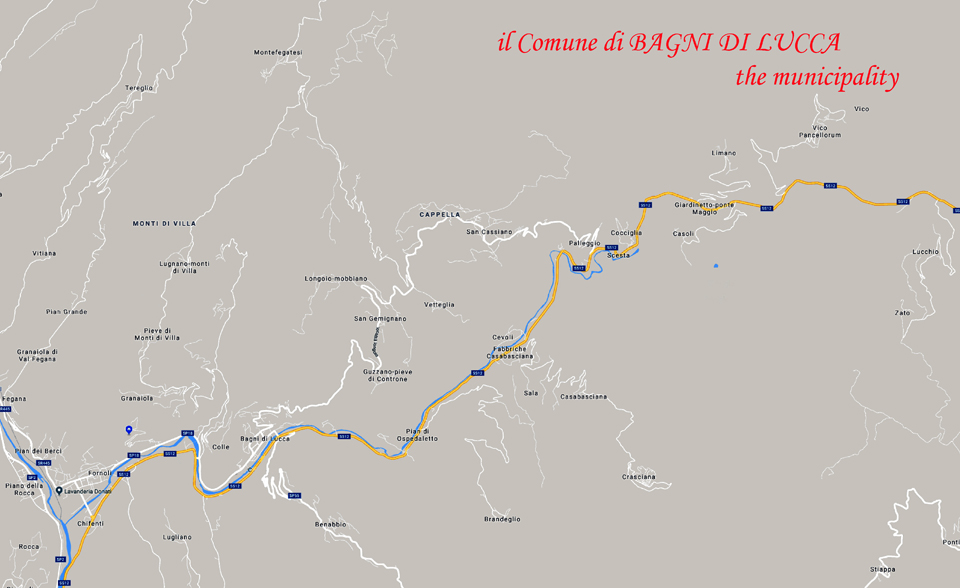
All worth visiting, the highest of the hamlets is
Montefegatesi (850 m asl), with its Dante Alighieri monument, which was inspired by the underlying Orrido di
Botri for the hell of the Divine Comedy.
The farthest is
Lucchio (670 m asl), a village now almost uninhabited and perched on a rocky spur with the fortress, and a church, dating
back to the early Middle Ages.
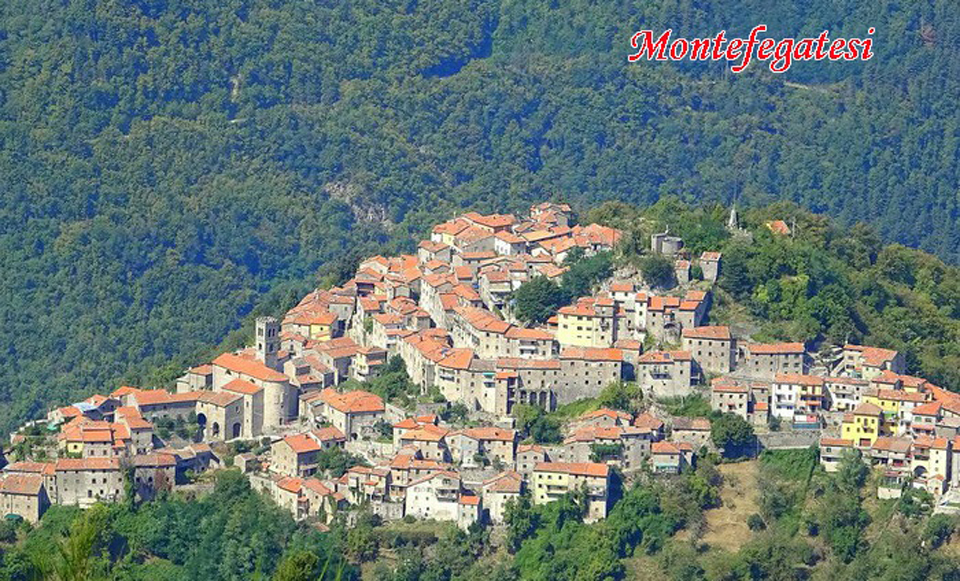
In the chief town, the Villa (220 m asl),
some buildings such as the Academic Theater of 1790, the English church,
the first Anglican church in Italy, built in 1800, today the municipal library, the
English cemetery of 1842, Villa Ada, now abandoned but in whose park there are active the
pubblic swimming pools, they are traces of what, alas,
was the most famous spa in Europe.
The thermal baths of Bagni di Lucca, already known at Rome time, before Christ, in the 19th century had seven spas with
sulphate-bicarbonate-calcium water that flows up to temperatures of 54 ° C;
today are open only the Bernabò thermal bath,
n the hill to east our farmhouse, on the valley the , Demidoff Hospital,
now an holistic medicine center.
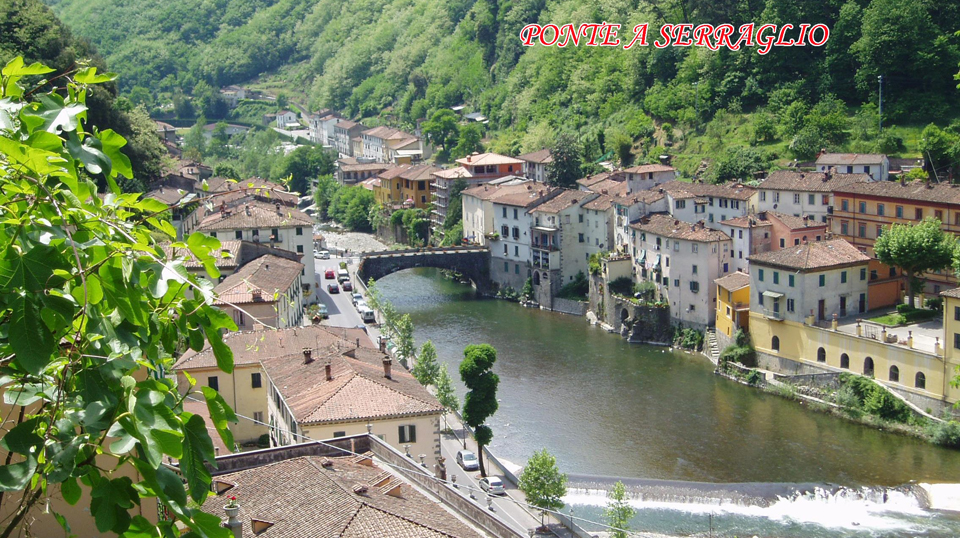
Down the hill, the characteristic village of Ponte a Serraglio,
once scattered with hotels and clubs for nobles and artists from all over Europe: Elisa Bonaparte, Boccaccio, Byron, Shelley, Heine, Carducci,
Montale, Rossini, Verdi, Puccini, are were among the guests in love with our spas and our landscapes, or perhaps the
Casino,the first Europen casino where was played roulette,
built in 1839, also mentioned in the Dumas' book "Le Comte de Monte-Cristo".
Bagni di Lucca also was the first place in Italy with electric public lighting (1886) and here the scout movement in Italy was born in 1910.
Worth seeing is the Ponte delle Catene, in Fornoli, built between 1844 and
1860 to a design by Lorenzo Nottolini, a work based on the innovative method, for the time, of suspension with iron chains.
In last years, a multitude of associations have been created in our area that promote natural resources by linking them to various activities, sport and adventure. We list below those closest to us that we consider safe.
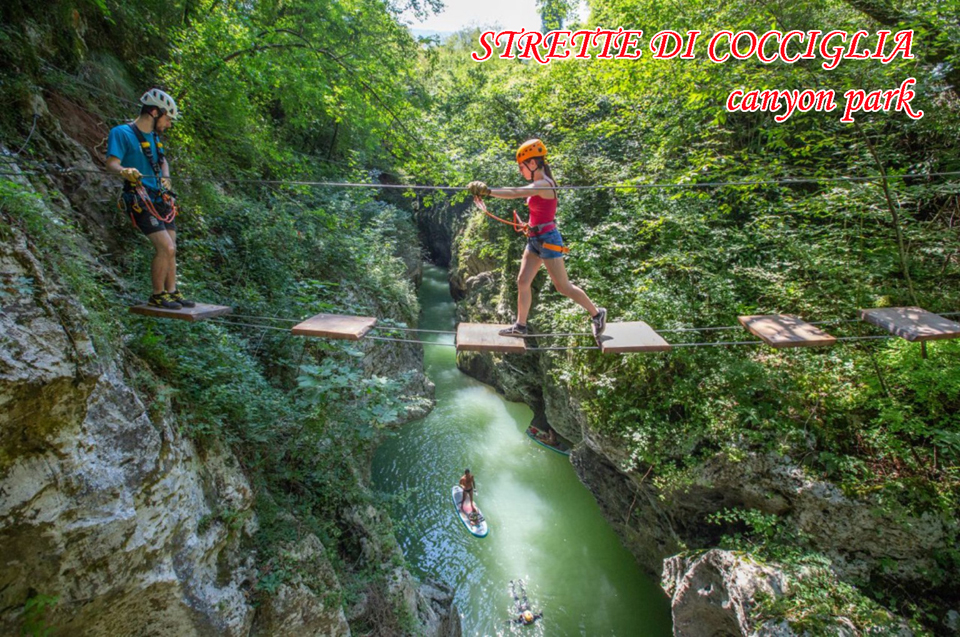
The Canyon Park is located at the
Strette di Cocciglia, in the municipality of Bagni di Lucca,
a magical place where crystal clear water and inaccessible rock walls surrounded by the green
of the neighboring woods are worth a visit just for a dip in the river.
In full respect of nature the park appears as if by magic in April and disappears at the end
of October without a trace, proposing Zip Line, with cableways, Tibetan bridges, slack lines
and passages on rock inside an otherwise inaccessible gorge, SUP (Stand UpPaddleboard)
and other yoga-like activities related to water and nature. For the activities we recommend
booking (www.canyonpark.it), for a swim it is recommended and that's it.
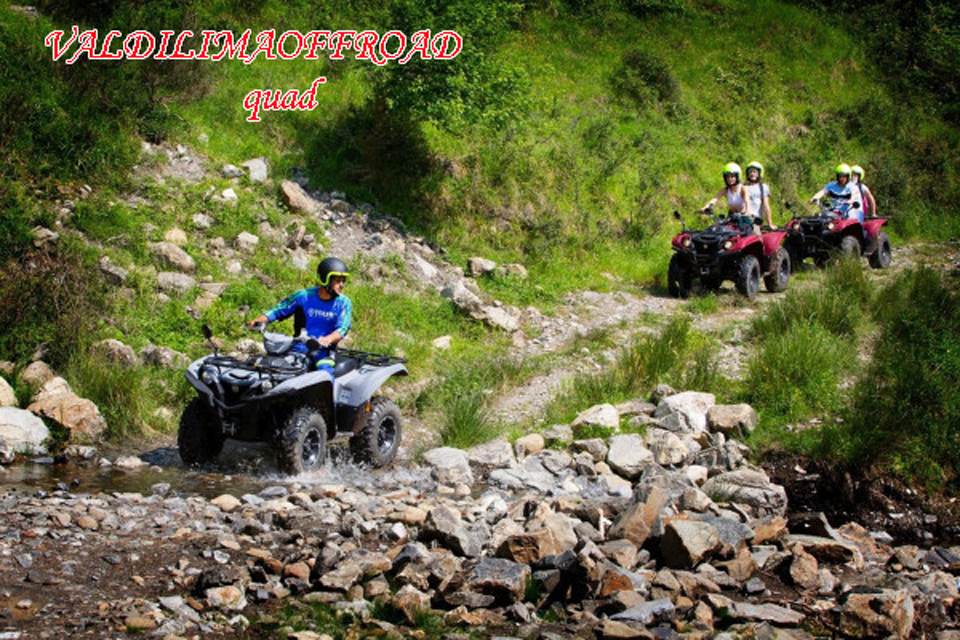
The was founded by a group of off-road enthusiasts linked by the love for our territory. Based in Bagni di Lucca, in the hamlet of San Cassiano di Controne it offers guided excursions by Quad, E-bike, Enduro and Vespa, for groups of Paintball battles, to discover that wild part of Tuscany that are our mountains, for a unforgettable experience.
The RockOnda are a group of enthusiasts for river sports who since 2013
have found in the waters of the Lima stream, in the Cevoli area,
the perfect place to give vent to this passion.
With guides certified by the Italian Rafting Federation you can choose between various types of adventures on the water:
rafting, packrafting, canyoning, kayaking, river trekking. They are not the only ones to do this type of activity on our stream,
but we trust them.
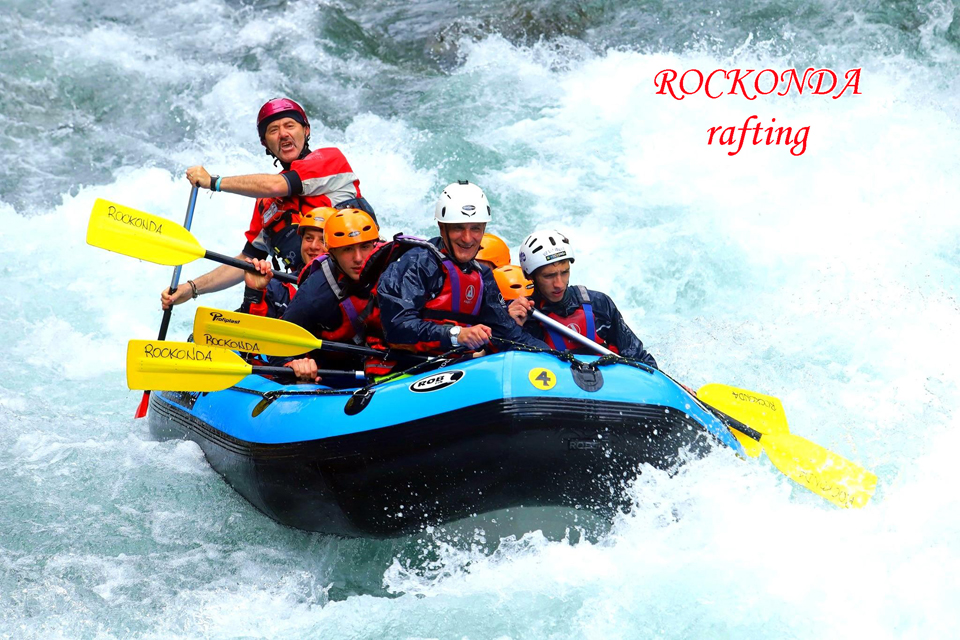
The Parco del Levigliese is located in the municipality of
Fabbriche di Vergemoli eand offers adrenaline in the heart of nature:
canyoning, climbing, survival courses, speleo-trips to natural caves, and other suggestive activities.
The Vagli Park s located in the heart of the Apuan Alps, in
Vagli Sotto , and offers a unique zip line: a flight of 1500 meters in length, at a height of over 300 meters on the underlying lake of Vagli,
at a maximum speed of almost 130 Km / h, alone or in pairs, with three different styles of flight (free style, angel flight or seated).
The park also offers a suspension bridge that crosses the lake with a ten-meter glass walkway in the center, as well as various thematic areas.
The hills and mountains around us offer many possibilities for walks or excursions for trekking enthusiasts. For the Apuan Alps, see the dedicated page,
here we limit ourselves to the surroundings of Bagni di Lucca and its mountains of the Tuscan-Emilian Apennines.
Starting from the farmhouse it is possible to walk along the
Via dell’Acqua, a 5.8 km ring that starts from Ponte a Serraglio, precisely at
la Cova, a source of thermal water on the main road, and has as its theme the waters thermal and the villas scattered
along the route, among which Villa Webb, seat of the impossible's museum,
is worth a visit. You arrive at the Villa to return along the river.
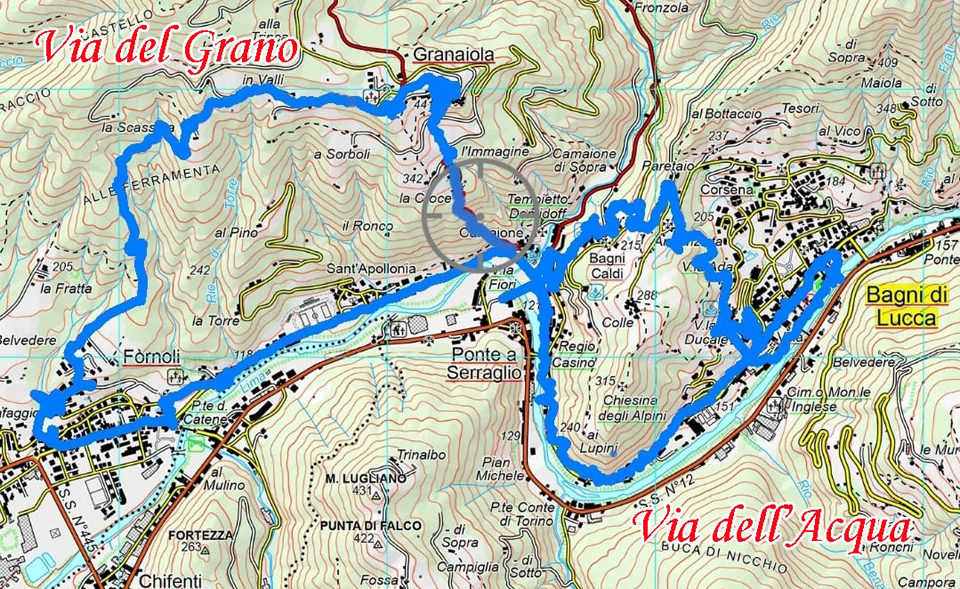
Another path that starts from the same place is the Via del Grano, but climbs along an old mule track to Granaiola (whose name is due to the cultivation of wheat) to turn on the hills above our farm and go down to Fornoli. The route indications show three ears of wheat, in total it is 9 km long, but it can be intercepted halfway through by continuing the road above the farmhouse following the white / red signs.
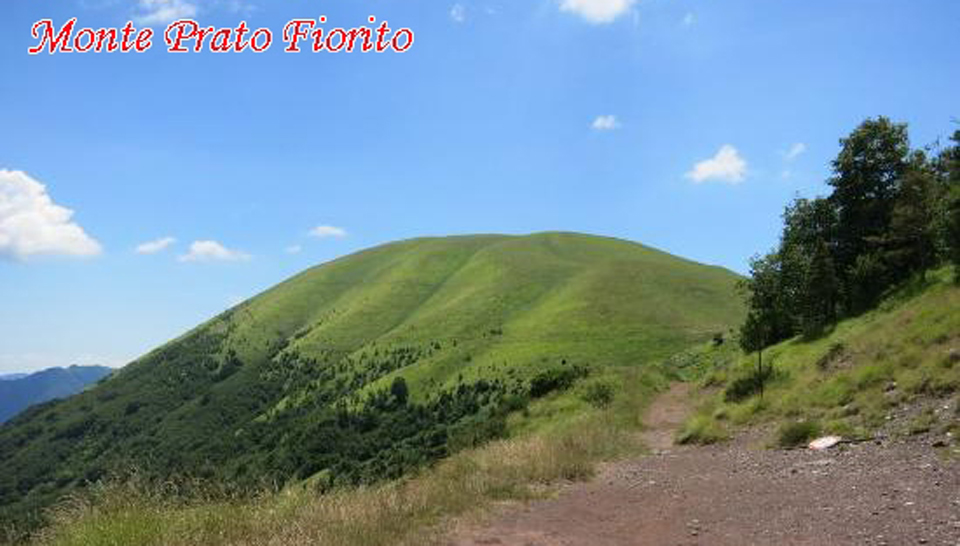
For mountain lovers, on the other hand, we undoubtedly recommend Prato Fiorito,
which dominates the Controneria's area and Bagni di Lucca, devoid of vegetation, a spectacle in the spring period when it is covered with colorful flowers.
For walkers there is only the embarrassment of choice: you can drive to
Foce al Lago (1103 m a.s.l.) and simply climb up to the summit of Monte Prato Fiorito (1297 m. A.s.l.), a hike of an hour not difficult.
To get to Foce al Lago follow the signs for Albereta, the road in the last few kilometers is unpaved but usually easily passable;
You can choose the
Alta Via del Pastori route, with departure and arrival in San Cassiano di Controne,
1103 m a.s.l., a development of about 9.5 km and an altitude difference of 800 m that allows you to climb to the top of Prato Flowered along
ancient mule tracks and suggestive grassy ridges once used by shepherds. Along the path there are 4 drinking troughs, a small cave, rocks
eroded by karst and an emergency shelter;
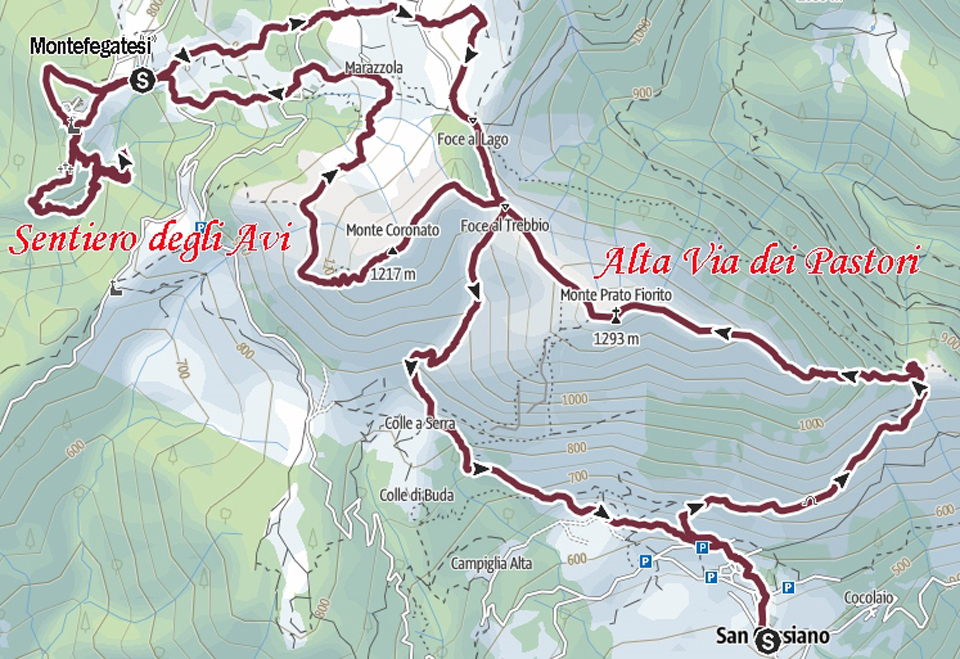
From the nearby village Montefegatesi it is instead possible to follow the path
Sentiero degli Avi , of about 12 km for a difference in height of about 750m and allows you to climb to the summit of Monte Coronato (1218 m )
crossing a remarkable variety of suggestive environments and from where you can appreciate a 360 ° panorama from the Apennines to the sea.
The tour is completed by a visit to the fascinating area of the Mills of Montefegatesi, where ancient ruins, streams and small waterfalls bring back memories of a time that was.
These two routes do not present particular difficulties and are well signposted.
From Foce al Lago you can also choose, among others, the CAI path 12, to reach the refuge of
Fontana a Troghi or with a small detour (clear but not signposted) to reach the Torretta, a remarkable panoramic pulpit on the Orrido di Botri, or Monte Mosca.
Another starting point for many more or less demanding walks is Foce a Giovo,
the extreme point of the Val Fegana, above the Orrido di Bostri on the border with the province of Modena.
From here it is possible to follow the CAI 00 path, which climbs the summit of Alpe Tre Potenze
(1940 m a.s.l.) to the east, on Monte Rondinaio (1964 m a.s.l.) and
Monte Giovo (1951 m a.s.l.) to the west, the path CAI 519 up to the small
Lago Piatto and continue on the CAI 200 up to the Lago Nero, descend, always with the CAI 519 up to the
Lago Santo Modenese.
In short, for all tastes.
The Orrido di Botri èis a Natural Reservoir of the State from 1971.
The Reservoir has surface of 286 hectares di 286 ettari and is inserted to the center of one protection Oasis of the fauna,
instituted in the 1993 from the Province of Lucca and extended for the surface of approximately 2.000 hectares, where is the prohibited hunting.
Draft of one imposing limestone throat much grip and with vertical walls, within which the cold waters of the torrent Rio Pelago,
in an Appennine landscape, dominated from the tops of the Rondinaio mount and the Tre Potenze that graze the 2,000 meters of height.
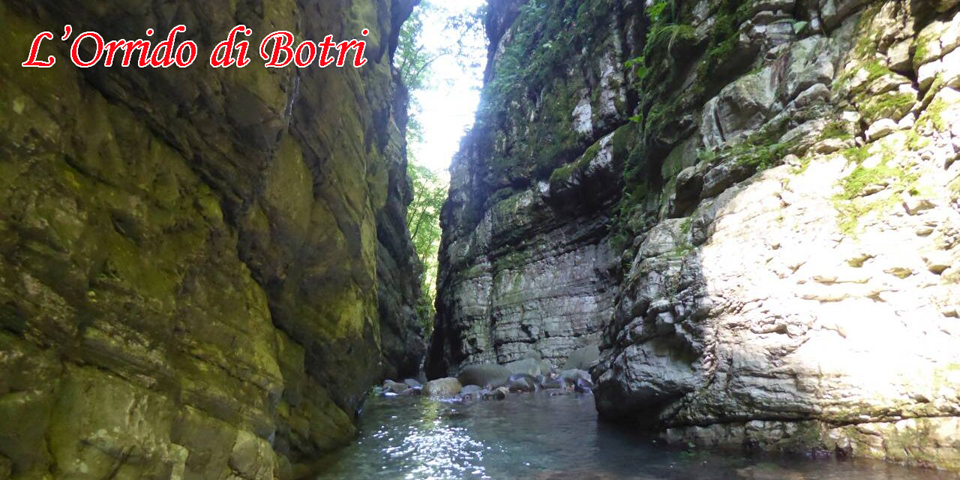
The visits to the inside of the Orrido di Botri must obligatorily be accompanied from authorized guides, with a closed number every day,
on two tracings of various hard work.
For the protection of the natural atmosphere and for the health of the hikers, the path that enters in the Orrido, following the bed of the torrent,
is covered alone in the summery period and demands however a sure engagement for frequent guadi and the slippery bottom.
It's obligatory the use of a protecting helmet, supplied on the place from the guides companions, while footwear adapted to the
type of excursion is recommended. The guided visits leave from Ponte a Gaio, only access to the throat.
The first thing you will see to Lucca are its walls, a splendid example
of defensive architecture. The ones we see today represent the last walls built over the centuries, built in the Renaissance period.
The ring of the walls, about four kilometers long. it is entirely passable… maybe by renting a bicycle.
Also known as the city of a hundred churches, yuo can see the Duomo di San Martino,
whose origins are to the sixth century and where the famous sculpture of Jacopo della Quercia: the sarcophagus of Ilaria del Carretto.
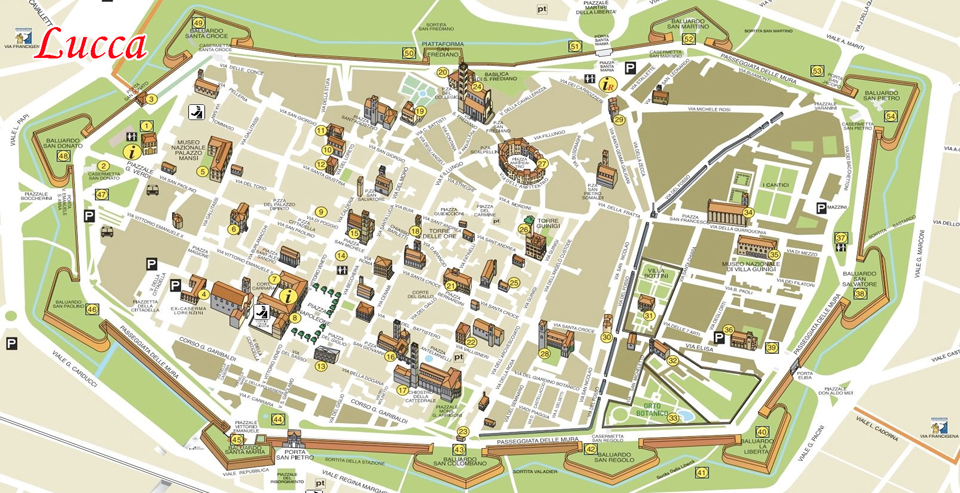
The most famous, however, is certainly the church of San Michele in Foro,
built in the eighth century where the Roman "forum" was located.
But the symbols of Lucca are the piazza del mercato o dell'anfiteatro,
built in the ancient structure of the Roman amphitheater, and the
Torre Guinigi with the garden and a huge holm oak on its top.
Also worth seeing are Palazzo Mansi, an example of Domus Lucchese
(horizontal development of the house), and home to a Museum and a Pinacoteca, the villa Guinigi museum,
da patrician residence of the 600/700 and where it is possible to admire, among the others, archaeological finds dating back to Roman and Etruscan times;
Palazzo Pfanner, cbuilt around 1667, with a beautiful garden and statues from the eighteenth century, and where the
Museum of Costume and Silk is located, the birthplace of the Lucca master
Giacomo Puccini, where the composer saw the light in 1858, today a museum of the Fondazione Puccini.
We advise against entering the city by car except to park in the parcheggio Mazzini
o in the parcheggio Cittadella,
but we recommend the parcheggio Palatucci, outside the walls but a few minutes from the centre.
n the municipalitie's territory of Lucca and Capannori, there are over two hundred historic villas, built and renovated between 1400 and 1800,
a sign of the wealth of many families from Lucca and their artistic fair, Renaissance, Baroque and Neoclassical, characterizing the buildings,
parks, gardens and fountains. We list some of them, which can be visited from April to early November, for timetables and costs login
villeepalazzilucchesi.it:
Villa Oliva in San Pancrazio village was built by the Buonvisi family
in the 1400s and was bombed during World War II.
Rebuilt and restored by the current owners, it features a huge porch at the back of the main building and a beautiful garden.
Nearby there is Villa Grabau, it's fully furnished with ancient furniture
and paintings and is surrounded by a 9 hectare botanical park.
The name comes from the last family that bought the property, Carolina von Grabau.
Villa Reale, is surrounded by a large park and it's the result of the works
by various owners over the centuries, but the current shape and size is due to Elisa Bonaparte, sister of Napoleon and princess of Lucca.
The Villa was later property of the King of Italy, until 1923..

Villa Mansi in Segromigno in Monte village dates back to the sixteenth
century and is certainly one of the most representative, with Villa Reale, of the society the ancient Aristocratic Republic of Lucca.
It was bought by the Marquis Raffaello Mansi in 1675 and remained with this family, at the time very well known in Europe in the silk trade,
until 2008. It's characterized by a raised portico accessible by two flights of stairs. On the facade the structural parts are gray stone,
the plaster are white-ocher, all decorated with numerous statues, coats of arms and frames.
Villa Torrigiani in Camigliano village is characterized by an imposing
façade with a triumphal, almost theatrical aspect, as is the park that surrounds it. Built in the 1500s, it owes its sumptuous current
appearance to the restoration done in the 1600s by the Marquis Nicolao Santini, ambassador of Lucca to the court of Louis XIV (Sun King).
There are many other villas to visit, but these are certainly the most beautiful and fascinating.
Barga is a small city going back to the time longobardo of the high Middle Ages (VI-VIII sec)
with an historical center of particular architectonic interest, situated to altitude 410 s.l.m. on one full of rocks spur in evocative position.
.
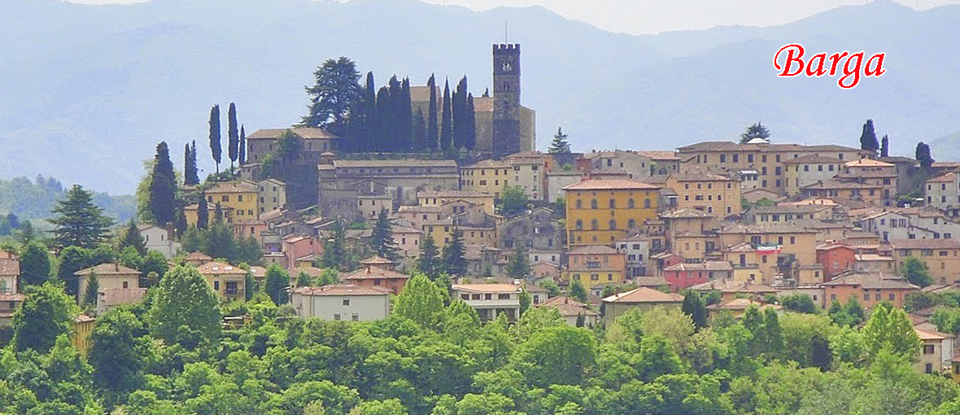
The structure urban planning puts into effect them of the Castle of Barga has the typical order of the village of the Middle Ages,
protect from one encircled accessible building from three doors: Porta Reale, Porta Macchiaia and Porta di Borgo.
In the high part of the castle it dominates the Dome, constructed from the sec. XI to the XVI, an example insigne of the Romanesque architecture
in the Serchio valley. The great garden that encircles the Dome conserve in the name of Arringo, the historical meant one of the place used after
the assemblies of the medieval people. The Pretorio Palace that closes to north the limit of the great garden and that it was residence of the
Commissioner of Florence from 1341 to 1859 is currently center of the Civic Museum.
From the large square of the Dome, for one wide perron, it is come down to the Church of the SS. Crocifisso, one of the antichi existing religious
buildings in the historical center.
To visit also the Teatro dei Differenti, constructed in 1795, on a previous one of 1689, and where on 26 November 1911 the poet Giovanni Pastures held,
in this theatre, the speech " Large the Proletarian is moved ", in occasion of the war of Libia and the Italian colonial resumption.
oing down to Castelvecchio Pascoli you can visit Giovanni Pascoli's house
where the poet lived the last years of his life and where he rests in the adjacent family chapel, now a museum dedicated to him.
The Grotta del vento is located in the center of the Apuan Alps Natural Park,
near Fornovolasco, and is one of the most complete caves in Europe,
presenting an extraordinary variety of phenomena that are illustrated with precision and competence by expert speleological guides.
Easy paths allow you to admire in the light of the spotlights all the wonders of the underground world: from the bright and living stalactites
and stalagmites, to the polychrome flows, to the alabaster draperies, to the ponds encrusted with crystals, to the underground streams and to
the bizarre shapes of erosion.
You can choose 3 itineraries among which the "first" has a flat course and almost everywhere covered with splendid calcareous concretions;
the "second", which also includes the first, offers the charm of vast rooms crossed by a small underground river; the "third" allows the complete
visit of the cave and travels in comfort along some perfectly vertical sections.
The cave is open every day of the year, except on Christmas day, but in the winter period from November to March it is possible to visit only the first itinerary.

On the road to Fornovolasco, about 4 Km. From Gallicano, it is advisable to visit the Eremo di Calomini, a striking hermitage and architectural complex located at the base of a large overhanging wall. rossing the gate and past the guesthouse, where a restaurant is open during the summer season, you reach the portico that adorns the facade of the sanctuary. From the main church, richly decorated in an eighteenth-century style, you enter the ancient sacristy which, presumably carved into the rock before the year 1000, was probably the original nucleus of the place of worship. It is also possible to visit the old kitchen and the cells of the friars, also excavated like the sacristy.
Castelnuovo is the chief town of the Garfagnana area.
The Rocca Ariostesca (where Ludovico Ariosto stayed from 1522 to 1525), dominates the main square and certainly dates back to the 13th century.
The recent town has developed around this, frankly with little to see.
On the road to Piazza al Serchio, after the Villetta,
town, you can admire the highest brick railway bridge in the Europe, it crosses the Serchio river when you see the picturesque church of
Sambuca.
Continue through the S. Romano town, it's dominated by the
Fortezza delle Verrucole, expertly restored and where, thanks to small guided tour, in addition to unique views, you can rediscover uses,
weapons and customs of the medieval era: it's open from April to October especially on weekends… it's worth it.

Not far away we point out the adventure park Selva del Buffardello,
ifree entrance to the park for a pleasant picnic as well as many adventure trails for children from 100 cm in height to adults.
Among thick chestnut groves and coniferous you arrive at the
Parco dell'Orecchiella, a state nature reserve where deer, fallow deer, wild boar and roe deer live in freedom. information and a beautiful
permanent exhibition on the naturalistic aspects of the Park. Not far away you can visit an interesting botanical garden.
As an alternative we recommend a visit to San Pellegrino in Alpe
(1525 m asl), a characteristic village divided to half: some houses have the living room in Tuscany and a kitchen in Emilia Romagna, the border
of the two regions cuts the country but also its buildings, as well the nearby Sanctuary of Santi Pellegrino e Bianco.
Not far away there is the Passo delle Radici, the main ski center in the area.
Returning to the valley we recommend a stop in Castiglione di Garfagnana,
a village of medieval origin dominated by a castle and completely surrounded by a wall with numerous works of military architecture.
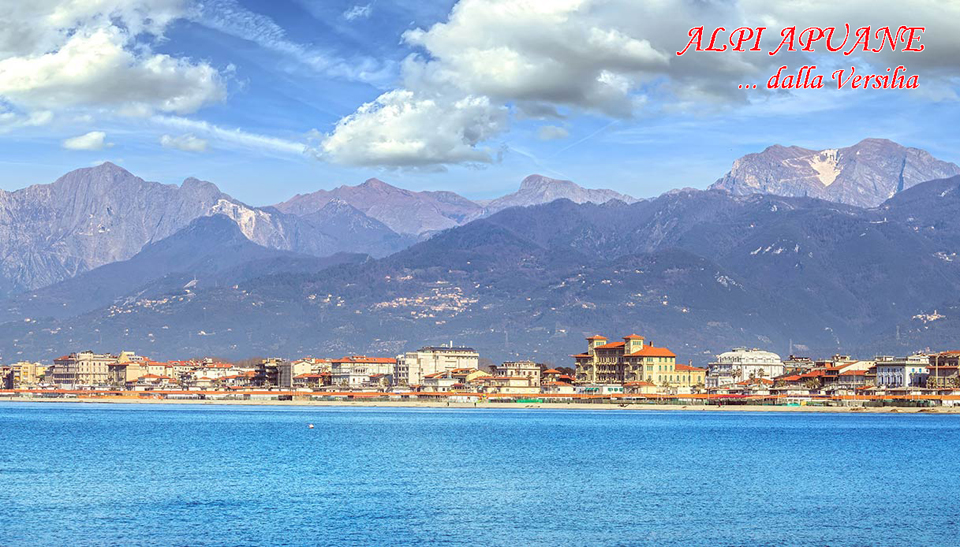
To divide the Garfagnana area from the beaches of the Garfagnana there are rugged and engraved mountains: the Apuan Alps. Views from the Versilia coast,
they rise energetically a few kilometers from the sea, touching the 2000 m s.l.m. with more peaks, they are scattered with over 2000 caves
(in addition to the Grotta del Vento, for lovers of the genre it is certainly worth visiting the
Antro del Corchia, in Levigliani, on the sea side of the Apuan Alps,
the largest known underground environment in Italy) and five lakes including
Lago di Gramolazzo, the only one where you can swim and where you can rent boats and canoes and there are picnic areas.
Also deserves a mention the Lago di Vagli, as the precedent of artificial
nature following the damming of the Edron stream in 1948, with a 93 meters high dam, which consequently submerged the town of Fabbriche di Careggine,
which re-emerges as by magic in the years of emptying the basin for maintenance work.
A little higher than Vagli the Campocatino,
a small village at 1000 m s.l.m., a naturalistic oasis of the LUPI, within a basin of glacial origin made up of small pastoral houses, called "caselli",
is certainly worth a visit. in stone, surrounded by large green spaces… it looks like a movie set. A refuge offers the possibility to eat and various trekking paths start from the village in the heart of the Apuan Alps.
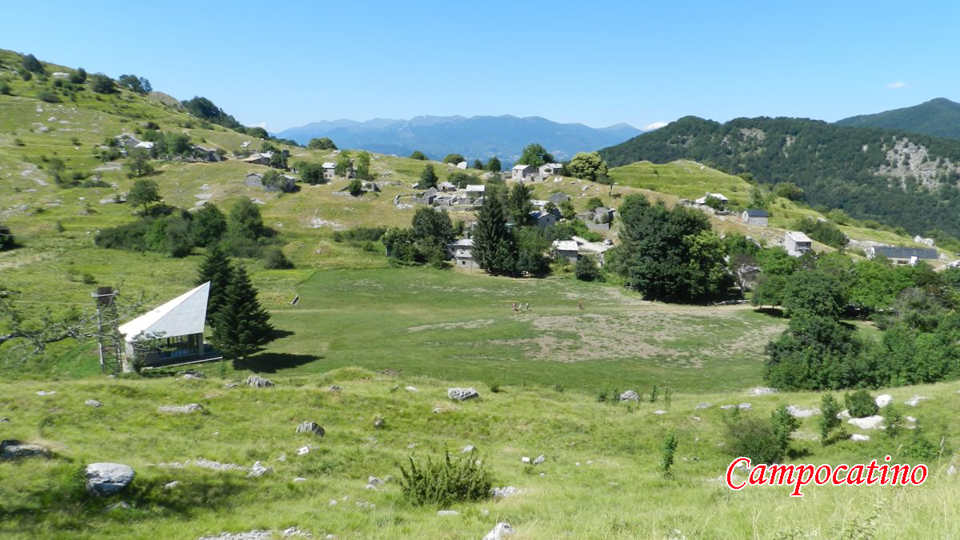
Another itinerary to get to know the Apuan Alps is that which, starting from Castelnuovo Garfagnana, on the Provincial Road 13, literally crosses the mountains to the sea. Along the way it is necessary to stop at Isola Santa, a characteristic village on the shores of a small artificial lake also partially submerged, now recovered, with a restaurant, in its ancient appearance dating back to the 12th century, when it was a rest village for travelers on the impervious route between Garfagnana and Versilia.
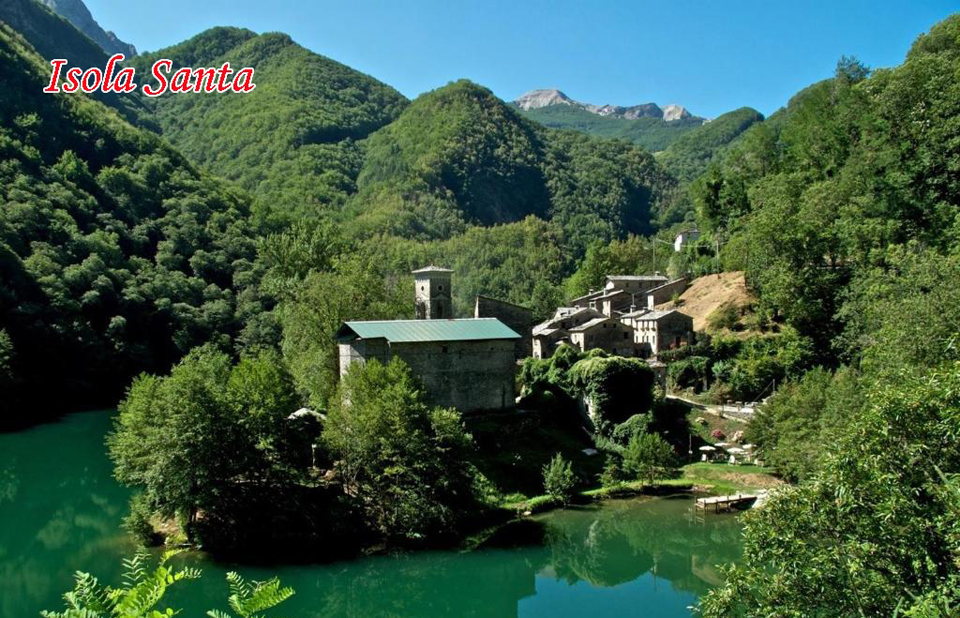
Continue on the provincial road and shortly after we recommend a stop at the Marmitte dei Giganti,
at the foot of Mount Sumbra. These are hemispherical cavities smoothed in the limestone rocks by the slow abrasion of detrital materials in correspondence
with the eddies of water of the Turrite Secca stream, where the water flows impetuously but only following heavy rainfall, common in the Apuan Alps.
One kilometer later is the cava Henraux, one of the many quarries of the famous white Carrara marble now abandoned.
PShortly after, the road divides at the foot of Monte Altissimo: towards the south you descend to Seravezza and then Forte dei Marmi (see VERSILIA) after crossing the
Passo del Cipollaio (800 m a.s.l.) the other, towards Arni, crosses instead
Passo del Vestito (1150 m a.s.l.) from where it is possible to see the sea with a breathtaking view.
This road goes down to Massa.
The Apuan Alps are fascinating, but, given their bristly and harsh morphology, we do not recommend going too far if you are not an expert:
every year these mountains are the cause of numerous accidents, more or less serious.
LVersilia includes the entire coastal strip of the Province of Lucca, bounded by the Tyrrhenian Sea to the west and the Apuan Alps to the east. The beaches of Versilia are renowned for being wide and sandy, well equipped (but with little space for free beaches), the holidays and the social life have made Versilia famous also in films.
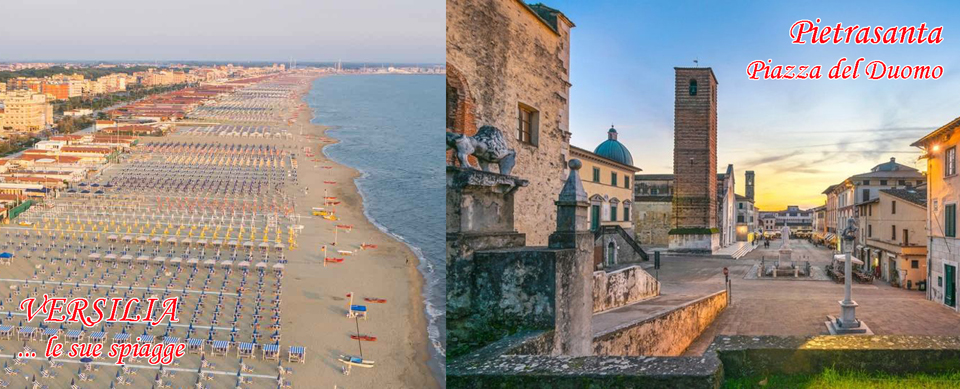
The symbol is Forte dei Marmi, certainly the most famous of the Versilia coastal resorts,
as well as the most expensive with luxury boutiques and highly sought-after restaurants.
A few kilometers inland the Pietrasanta is the most historic, with a history linked to
marble that has led it to be chosen by many artists, with a beautiful square dominated by the 14th-century Cathedral of San Martino.
rom Marina di Pietrasanta, going down towards the south, you will find Lido di Camaiore
and Viareggio, characterized by the wide promenade that connects them, a succession of bathrooms,
restaurants and shops for almost 5 km. AIn the center of Viareggio a large pine forest for refreshments in the hot summers with games and other activities.
IThe southernmost town is Torre del Lago Puccini, located between the sea and Lake Massaciuccoli,
from which it takes its name, to which in 1938 was added that of the composer Giacomo Puccini, who lived and composed many of his operas.
His residence,Villa Puccini, on Lake Massaciuccoli, can be visited and is a destination for tourists
and opera enthusiasts from all over the world and houses the artist's tomb.
Personally, if we have to recommend a place for a day on the sea, the answer is
Marina di Vecchiano, on the border with the province of Pisa, in the heart of the San Rossore Natural Park, the only part of the coast not yet contaminated by smassa
tourism ( even if in the high season weekends it is still crowded), where the equipped beach and services are a small part of the free beach, which is still "wild".
Il ponte sospeso delle Ferriere is a footbridge that connects the two sides of
the Lima stream, between Mammiano Basso and Popiglio, in the municipality of San Marcello Piteglio.
It is made with structures that rest on four steel cables kept in tension; it measures 227 meters in length, 36 meters in height and 80 centimeters in width.
In 1990 it was listed in the Guinness Book of Records as "the longest pedestrian suspension bridge in the world".
Since 2006, the record has been held by the Kokonoe Yume suspension bridge in Japan
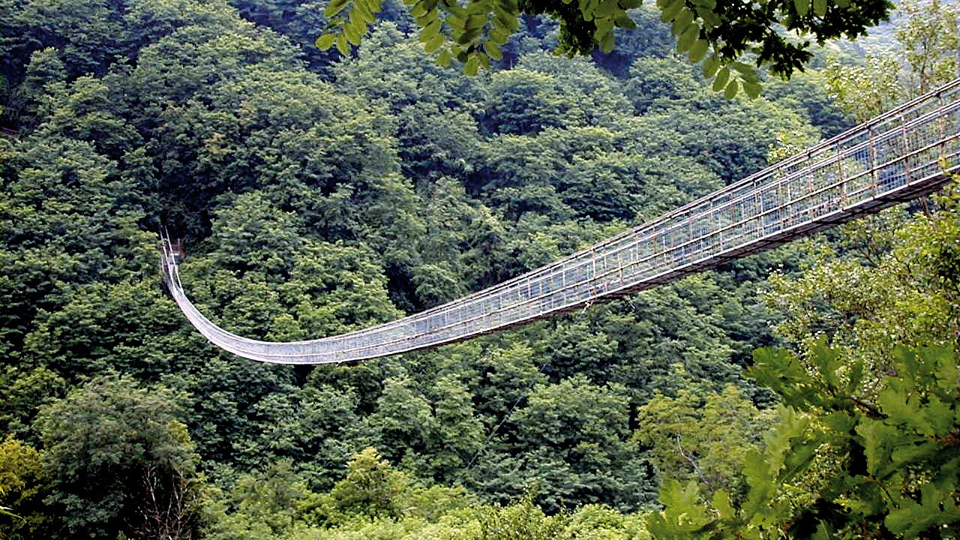
Inaugurated in June 1923, it was built following the idea of Vincenzo Douglas Scotti, Count of San Giorgio della Scala, director of the Italian Metallurgical Society.
It served for the passage of the workers who went to work in the factories located on the opposite side: without the bridge, in fact, the workers walked about 6 kilometers to get to work.
The work, which has lost its original function, has undergone major maintenance and consolidation work over the years.
The last ones in 2004 made it possible to secure the bridge, making it more stable and resistant through the complete replacement of cables, side tie rods, walkways and protections,
with more resistant and lighter material.
The fame of the town of Collodi is essentially due to the name of Carlo Lorenzini,
author of the tale of Pinocchio.
His mother, a waitress at the Garzoni family, was originally from this small town, and the writer lived most of his
childhood here, choosing the pseudonym of Carlo Collodi.
The ancient town, located in the province of Pistoia, in Pescia, dates back to the 12th century and is characterized by the imposing Villa Garzoni,
in a style typical of the Lucca villas. At the gates of the town itself, which was once only accessed by two paved streets that passed through the main
entrance of the building, it climbs a hill with a beautiful Italian garden, with statues and water features.
Fortunately, the architectural complex of Collodi and the villa has remained unchanged for centuries and still allows you to savor an atmosphere of other times..
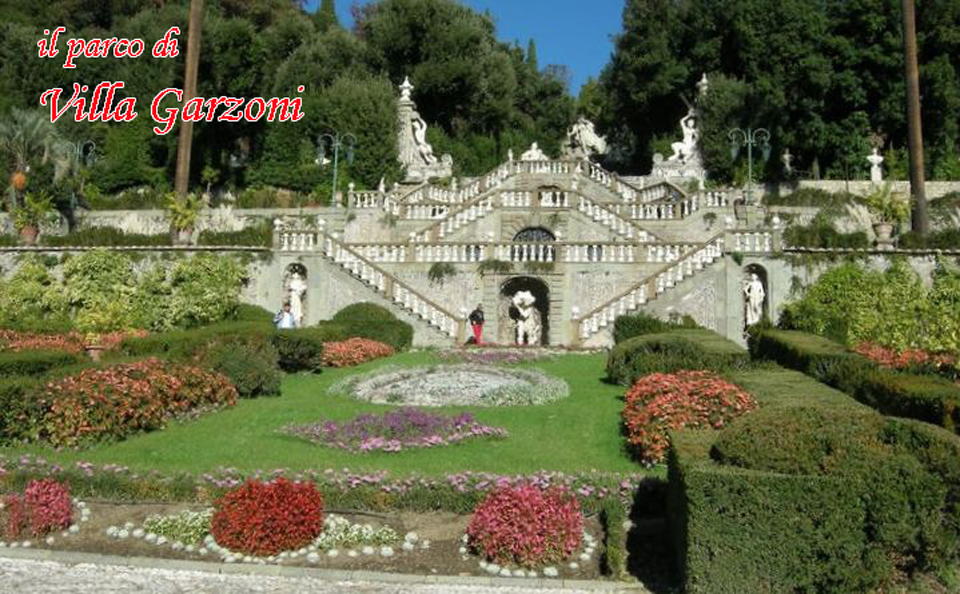
Inside the park you can also visit the Butterfly House, inhabited by hundreds of butterflies native to tropical or equatorial areas, among the largest and most colorful,
free to fly in a tropical garden, lush with plants, flowers and fruits thanks to the perfect reconstruction of the original environment.
n the opposite valley in 1956 the memorial parco di Pinocchio, ua set of sculptures and works that celebrate the famous fairy tale.
Honestly it needs a makeover, but it is also true that it is a theme park, not the usual amusement park, and recently a small adventure area for children has been added.
Pisa has one of the most famous monumental complexes in the world:
the Piazza dei Miracoli, as defined by D'annunzio, with the Cathedral, the Baptistery, the Monumental Cemetery and the Bell Tower, the famous Leaning Tower.
These Pisan Romanesque jewels have been enriched over the centuries by the works of Nicola and Giovanni Pisano, Cimabue, Taddeo Gaddi, Benozzo Bozzoli,
Andrea del Sarto, Giambologna and other famous artists.
LThe Cathedral, begun in 1063, presents externally very rich decorations with multicolored marbles, mosaics and numerous bronze objects,
with pointed arches of Muslim influence. The interior is covered with black and white marble, has a gilded coffered ceiling and some frescoes,
extensively redecorated after the fire that devastated it in 1595. The building, like the tower, sunk into the ground already during construction,
as visible from the differences in level between the internal naves.
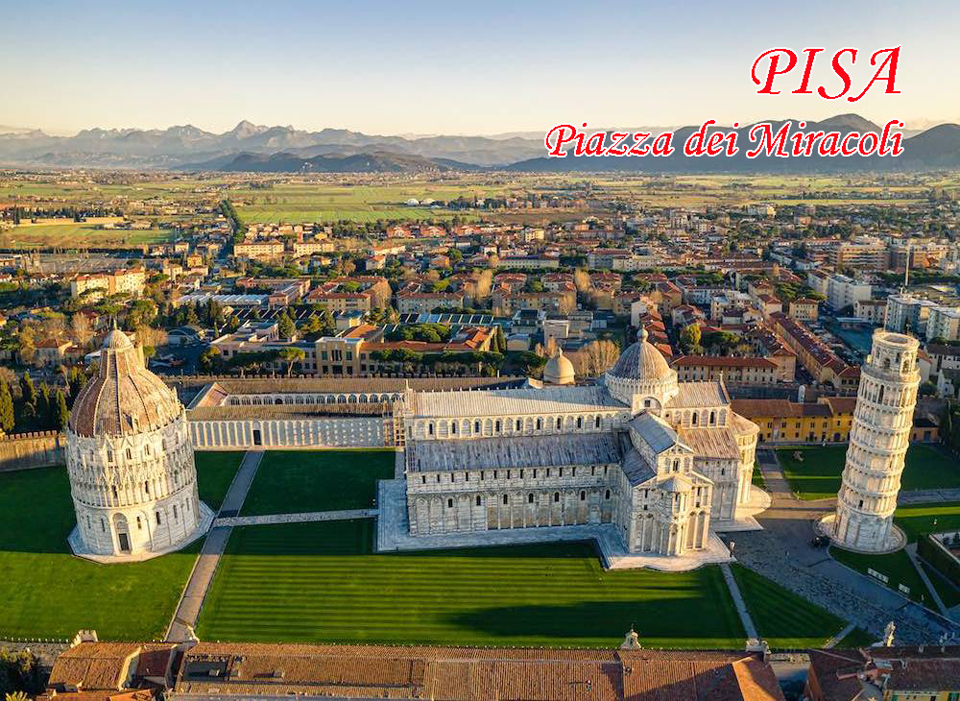
The Baptistery, dedicated to San Giovanni Battista, facing the west facade of the Cathedral, was begun in the mid-twelfth century
but remained unfinished until the fourteenth century. It is the largest baptistery in Italy with a circumference of 107.25 m.
The surprisingly simple and unadorned interior also has exceptional world-famous acoustics.
The Camposanto is located at the northern limit of the Piazza, it was begun in 1278 but completed only in 1464 and is practically a covered cemetery.
In 1944 the fire following an allied bomb caused the roof to collapse causing extensive damage to the many frescoes and works kept there.
The Campanile, or bell tower, is probably the most famous tower in the world: begun in 1173, it began to tilt before the third order was completed (1274).
However, construction continued trying to correct the inclination and was completed in 1350, when the belfry and the seven bells were completed.
The height is about 56 m, the slope of about 5 m from the vertical. Following the restorations of the late twentieth century, which settled the slope,
it was reopened to the public (forbidden to children under 10) ... the price of the ticket is objectively expensive.
In Pisa it is also worth visiting Piazza dei Cavalieri, renovated by the Medici in the 16th century. by Giorgio Vasari: the Palazzo Della Carovana transformed
by Napoleon Bonaparte into the seat of the Scuola Normale Superiore, the church of S. Stefano dei Cavalieri and the Torre della Fame where Count Ugolino
della Gherardesca was imprisoned.
Objectively not very well cared for in the remaining part of the city, the Lungarni, on the banks of the Arno, are worth a visit, walking under the arches
of Borgo Stretto and then admire the Church of San Michele, the church of Santa Maria della Spina, the noble palaces and the structures of the ancient tower-houses,
the bridges and the Citadel with its Guelph tower.
To reach Pisa by car we recommend the S.S. n. 12, which, in addition to being the shortest, after crossing the
il Foro, the so-called gallery that divides the provinces of Lucca and Pisa, offers a beautiful view of the city and its surroundings.
How not to recommend a visit to Florence, the capital of the Tuscany Region
and one of the most important cities of art in the world. One day is certainly not enough to appreciate all its beauties, but we still provide
you with a list of the main attractions.
Santa Maria del Fiore, the Duomo of Florence, is the symbol of the Italian Renaissance and the fourth largest church in the world, and whose dome,
completed by the architect and sculptor Filippo Brunelleschi in 1436, was then completely frescoed by Vasari and by Zuccai.
It is possible to climb to the top of the cathedral to enjoy a beautiful view of the city. To the right of the Cathedral stands the Bell Tower,
designed by Giotto in 1334.
In front of the Cathedral, the Baptistery of San Giovanni from 1128, in Florentine Romanesque style, covered in white and green marble.
In the Museo dell'Opera del Duomo there are works of art from S. Maria del Fiore, the Baptistery and the Bell Tower, including works
by Michelangelo (Pietà), Donatello (La Maddalena, the Cantoria), Arnolfo di Cambio (Bonifacio VIII), Luca della Robbia (Cantoria).
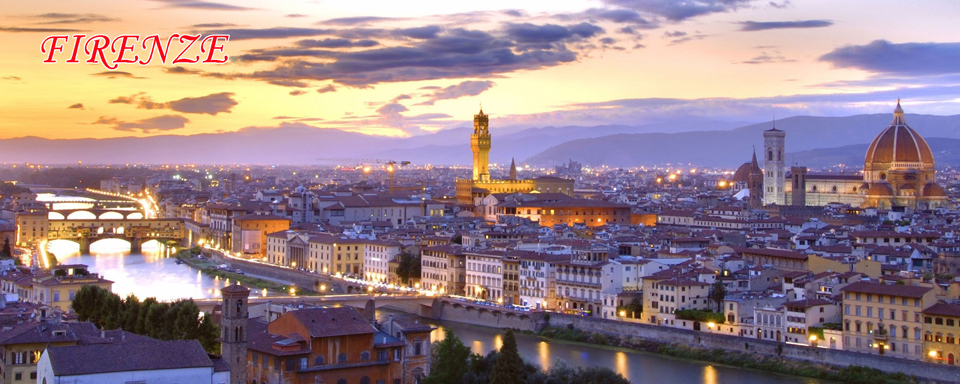
Palazzo Vecchio, is one of the symbols of Florence, built in the fourteenth century, an impressive figure on Piazza della Signoria,
the center of the political and social life of the city for centuries, undoubtedly the most beautiful square in Florence.
The main entrance of Palazzo Vecchio is near the Loggia dei lanzi, built between 1376 and 1382 to host the assemblies of the people and public ceremonies.
The Galleria degli Uffizi in Florence houses the most important art collection in the world.
The building, located in Piazza della Signoria near the Arno river, was designed in the 16th century by the painter and architect Giorgio Vasari
to house the government offices (Uffizi), and was transformed into the Medici art gallery in 1737.
Some of the extraordinary masterpieces displayed in the 45 halls and corridors include Botticelli's "The Birth of Venus" and "La Primavera",
Leonardo's "The Annunciation", as well as frescoes by Giotto, Titian, Tintoretto and Raphael. Later periods are represented by Caravaggio,
Van Dyck and Rembrandt, and there are also many antiquities, sculptures, paintings and prints on display… it is advisable to book your ticket online in advanc.
Another symbol of the city is Ponte Vecchio, the oldest bridge over the Arno in the city, a structure with three stone arches whose upper part,
called the Vasari Corridor, was designed by Vasari to join Palazzo Vecchio and the Uffizi gallery to Palazzo Pitti; today it is a beautiful art gallery.
Palazzo Pitti, said to have been designed by Brunelleschi, has always been one of the "royal" palaces of Florence. Today, the palace and the Boboli gardens house
some of the most important Florentine museums. On the first floor, there is the Palatine Gallery, on the ground floor and the mezzanine there is the Museo degli Argenti,
and the Gallery of Modern Art. In the nearby Palazzina del cavaliere at the top of the Boboli Gardens, there is the Costume Gallery.
Among the many churches in Florence, the following deserve a mention: Santa Croce, the largest Franciscan church in Florence, whose construction began in 1295
and was completed in 1442; Santa Maria Novella, begun in 1246 on the spot where the oratory of Santa Maria delle Vigne was located in the 10th century;
San Lorenzo, whose old sacristy was designed by Brunelleschi to distinguish it from the new one built in the 16th century in the same church by Michelangelo;
Santo Spirito, on the left side of the Arno, whose interior is truly rich in works of art.
To get to Florence, our advice is by train, but also by car, parking in the large underground car park of Santa Maria Novella, the central station...
from there in a few minutes you can visit the most interesting things ...except
Piazzale Michelangelo , more that a square is a real panoramic terrace on the city built at the time when Florence was the capital of Italy, reachable by car or public transport.